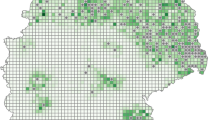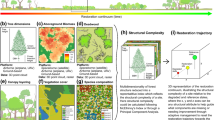Abstract
The expected presence/absence of a target species outside the area of actual observations is commonly estimated using statistical models or decision criteria. This investigation demonstrates a similarity-based solution for predictive mapping as an alternative to generalizing models. The maps of the expected distribution of 12 orchids were created using find sites from field observations and absence sites generated onto the observation track. The expected presence/absence of a species in a location was calculated according to the similarity between the location and selected examples of presence and absence sites. A machine learning system selected the best predictive sets for each species out of 161 cartographic and remote sensing features. The usefulness of the predictive distribution maps was expressed as the ratio of the density of find sites per track in the predicted presence area relative to the density per track in the predicted absence area. The predictive mapping was more efficient for Dactylorhiza incarnata, D. russowii, Gymnadenia conopsea, and Goodyera repens. Soil properties and the proportion of find sites for the other species in the vicinity were the most indicative site characteristics. The rarer species were found to be better indicators of the occurrence of the other species than were the more common orchids. The proposed approach—to direct subsequent field observations to sites where the occurrence of the target species was predicted but has not yet been recorded—helped discover new populations of orchids and enhance the representativeness of absence sites.





Similar content being viewed by others
Abbreviations
- EELIS:
-
Estonian Nature Infosystem, a government database of protected areas and verified permanent find sites of protected species
- SRTM:
-
Shuttle Radar Topography Mission of the US National Aeronautics and Space Administration
- DEM:
-
Digital land surface elevation model
- TM:
-
Thematic Mapper, the remote sensing sensor on board satellite Landsat 5
- ETM+:
-
Enhanced Thematic Mapper, the remote sensing sensor on board satellite Landsat 7
- RGB:
-
Red–green–blue, a data format for digital images
- NDVI:
-
Normalized difference vegetation index calculated as NDVI = (B4 − B3)/(B4 + B3), where B3 and B4 are the red and near-infrared reflectance bands from a Landsat image
References
Aha DW (1998) The omnipresence of case-based reasoning in science and application. Knowl Base Syst 11:261–273. doi:10.1016/S0950-7051(98)00066-5
Austin MP (2002) Spatial prediction of species distribution: an interface between ecological theory and statistical modelling. Ecol Modell 157:101–118. doi:10.1016/S0304-3800(02)00205-3
Benayas JMR, de la Montaña E (2003) Identifying areas of high-value vertebrate diversity for strengthening conservation. Biol Conserv 114:357–370. doi:10.1016/S0006-3207(03)00064-8
Brzosko E (2002) The dynamics of Listera ovata populations on mineral islands in the Biebrza National Park. Acta Societatis Botanicorum Pol 71:243–251
Carpenter G, Gillison AN, Winter J (1993) DOMAIN: a flexible modelling procedure for mapping potential distributions of plants and animals. Biodivers Conserv 2:667–680. doi:10.1007/BF00051966
Chiarucci A, D’Auria F, Bonini I (2007) Is vascular plant species diversity a predictor of bryophyte species diversity in Mediterranean forests? Biodivers Conserv 16:525–545. doi:10.1007/s10531-006-6733-1
Coudun C, Gégout JC (2006) The derivation of species response curves with Gaussian logistic regression is sensitive to sampling intensity and curve characteristics. Ecol Modell 199:164–175. doi:10.1016/j.ecolmodel.2006.05.024
Dennis RLH, Shreeve TG (2003) Gains and losses of French butterflies: tests of predictions, under-recording and regional extinction from data in a new atlas. Biol Conserv 110:131–139. doi:10.1016/S0006-3207(02)00184-2
Dennis RLH, Sparks TH, Hardy PB (1999) Bias in butterfly distribution maps: the effects of sampling effort. J Insect Conserv 3:33–42. doi:10.1023/A:1009678422145
Dennis RLH, Shreeve TG, Sparks TH, Lhonore JE (2002) A comparison of geographical and neighbourhood models for improving atlas databases. The case of the French butterfly atlas. Biol Conserv 108:143–159. doi:10.1016/S0006-3207(02)00101-5
Dirnböck T, Dullinger S, Gottfried M et al (2003) Mapping alpine vegetation based on image analysis, topographic variables and canonical correspondence analysis. Appl Veg Sci 6:85–96. doi:10.1658/1402-2001(2003)006[0085:MAVBOI]2.0.CO;2
Engler R, Guisan A, Rechsteiner L (2004) An improved approach for predicting the distribution of rare and endangered species from occurrence and pseudo-absence data. J Appl Ecol 41:263–274. doi:10.1111/j.0021-8901.2004.00881.x
Ferrier S, Watson G, Pearce J, Drielsma M (2002) Extended statistical approaches to modelling spatial pattern in biodiversity in northeast New SouthWales. I. Species-level modelling. Biodivers Conserv 11:2275–2307. doi:10.1023/A:1021302930424
Franklin J (1995) Predictive vegetation mapping: geographic modelling of biospatial patterns in relation to environmental gradients. Prog Phys Geogr 19:474–499. doi:10.1177/030913339501900403
Gibson LA, Wilson BA, Aberton JG (2004) Landscape characteristics associated with species richness and occurrence of small native mammals inhabiting a coastal heathland: a spatial modelling approach. Biol Conserv 120:75–89. doi:10.1016/j.biocon.2004.01.027
Hirzel AH, Hausser J, Chessel D, Perrin N (2002) Ecological-niche factor analysis: how to compute habitat-suitability maps without absence data? Ecology 83:2027–2036
Irfan-Ullah M, Amarnath G, Murthy MSR, Peterson AT (2007) Mapping the geographic distribution of Aglaia bourdillonii Gamble (Meliaceae), an endemic and threatened plant, using ecological niche modeling. Biodivers Conserv 16:1917–1925. doi:10.1007/s10531-006-9110-1
Johnson CJ, Gillingham MP (2005) An evaluation of mapped species distribution models used for conservation planning. Environ Conserv 32:1–12. doi:10.1017/S0376892905002171
Kukk T, Kull T (2005) Eesti taimede levikuatlas (Atlas of the Estonian Flora). Estonian University of Life Sciences, Tartu
Kull T, Hutchings MJ (2006) A comparative analysis of decline in the distribution ranges of orchid species in Estonia and the United Kingdom. Biol Conserv 129:31–39. doi:10.1016/j.biocon.2005.09.046
Lassueur T, Joost S, Randin CF (2006) Very high resolution digital elevation models: do they improve models of plant species distribution? Ecol Modell 198:139–153. doi:10.1016/j.ecolmodel.2006.04.004
Lehmann A, Leathwick JR, Overton JMC (2002) Assessing New Zealand fern diversity from spatial predictions of species assemblages. Biodivers Conserv 11:2217–2238. doi:10.1023/A:1021398729516
Manel S, Dias J-M, Ormerod SJ (1999) Comparing discriminant analysis, neural networks and logistic regression for predicting species distributions: a case study with a Himalayan river bird. Ecol Modell 120:337–347. doi:10.1016/S0304-3800(99)00113-1
Muinonen E, Maltamo M, Hyppänen H, Vainikainen V (2001) Forest stand characteristics estimation using a most similar neighbour approach and image spatial structure information. Remote Sens Environ 78:223–228. doi:10.1016/S0034-4257(01)00220-6
Nilsen L, Brossard T, Joly D (1999) Mapping plant communities in a local Arctic landscape applying a scanned infrared aerial photograph in a geographical information system. Int J Remote Sens 20:463–480. doi:10.1080/014311699213541
Osborne PE, Alonso JC, Bryant RG (2001) Modelling landscape-scale habitat use using GIS and remote sensing: a case study with great bustards. J Appl Ecol 38:458–471. doi:10.1046/j.1365-2664.2001.00604.x
Ottaviani D, Lasinio GJ, Boitani L (2004) Two statistical methods to validate habitat suitability models using presence-only data. Ecol Modell 179:417–443. doi:10.1016/j.ecolmodel.2004.05.016
Pearman PB, Weber D (2007) Common species determine richness patterns in biodiversity indicator taxa. Biol Conserv 138:109–119. doi:10.1016/j.biocon.2007.04.005
Reese H, Nilsson M, Granqvist Pahlén T et al (2003) Countrywide estimates of forest variables using satellite data and field data from the National Forest Inventory. Ambio 32:542–548. doi:10.1639/0044-7447(2003)032[0542:CEOFVU]2.0.CO;2
Reese GC, Wilson KR, Hoeting JA, Flather CH (2005) Factors affecting species distribution predictions: a simulation modeling experiment. Ecol Appl 15:554–564. doi:10.1890/03-5374
Remm K (2004) Case-based predictions for species and habitat mapping. Ecol Modell 177:259–281. doi:10.1016/j.ecolmodel.2004.03.004
Remm K (2005) Correlations between forest stand diversity and landscape pattern in Otepää Nature Park, Estonia. J Nat Conserv 13:137–145. doi:10.1016/j.jnc.2005.02.001
Remm M, Remm K (2008) Case-based estimation of the risk of enterobiasis. Artif Intell Med 43:167–177. doi:10.1016/j.artmed.2008.04.002
Remm K, Linder M, Remm L (2008) Relative density of finds for assessing similarity-based maps of orchid occurrence. Ecol Modell. doi:10.1016/j.ecolmodel.2008.10.017
Rodríguez JP, Brotons L, Bustamante J, Seoane J (2007) The application of predictive modelling of species distribution to biodiversity conservation. Divers Distrib 13:243–251
Stockwell DRB, Peterson AT (2002) Effects of sample size on accuracy of species distribution. Ecol Modell 148:1–13. doi:10.1016/S0304-3800(01)00388-X
Tomppo E, Nilsson M, Rosengren M et al (2002) Simultaneous use of Landsat-TM and IRS-1C WiFS data in estimating large area tree stem volume and aboveground biomass. Remote Sens Environ 82:156–171. doi:10.1016/S0034-4257(02)00031-7
Tsoar A, Allouche O, Steinitz O et al (2007) A comparative evaluation of presence-only methods for modelling species distribution. Divers Distrib 13:397–405
Wilds S, Boetsch J, van Manen FT et al (2000) Modeling the distributions of species and communities in Great Smoky Mountains National Park. Comput Electron Agric 27:389–392. doi:10.1016/S0168-1699(00)00104-6
Wright C, Gallant A (2007) Improved wetland remote sensing in Yellowstone National Park using classification trees to combine TM imagery and ancillary environmental data. Remote Sens Environ 107:582–605. doi:10.1016/j.rse.2006.10.019
Acknowledgements
Maps and orthophotos were used according to Estonian Land Board licences No 107, 995, 1350. The investigation was supported by the Estonian Ministry of Education (SF0180052s07). The authors are grateful to Anneli Palo for adding field records, to Tiiu Kelviste and Madli Linder for assistance in technical tasks, to Michael Haagensen for proofreading the text, and to two anonymous reviewers for useful critical comments.
Author information
Authors and Affiliations
Corresponding author
Rights and permissions
About this article
Cite this article
Remm, K., Remm, L. Similarity-based large-scale distribution mapping of orchids. Biodivers Conserv 18, 1629–1647 (2009). https://doi.org/10.1007/s10531-008-9547-5
Received:
Accepted:
Published:
Issue Date:
DOI: https://doi.org/10.1007/s10531-008-9547-5




